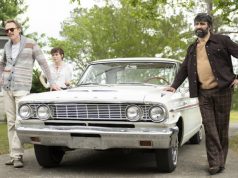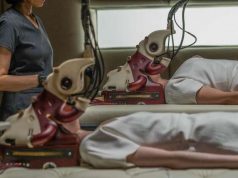I hope it doesn’t make me a racist or anything to admit that I love films about loud, argumentative Italians (especially if they live in New York), and that I’ve always found lilting Irish accents amusing. Put all those elements into one warm-hearted, funny little movie, and I’m sold.
“Two Family House” is such a movie, based on writer/director Raymond De Felitta’s real life relatives and obviously a labor of love for him. Set on a very sunny Staten Island in 1956, Buddy Visalo (Michael Rispoli) is a perpetual loser who, despite it all, remains gruffly optimistic. A would-be crooner, he missed his big chance 11 years earlier, when his then-fiancee Estelle (Kathrine Narducci) wanted him to pursue something more stable. So they’ve spent the last decade living in her parents’ house, Buddy working at a factory and periodically trying various make-a-better-life endeavors. Nothing that would make them rich, mind you; just something a little more interesting that would help them get their own house.
Despite being unable to afford it, Buddy buys a house which he intends to live in the top half of while converting the bottom half into a bar. Estelle, a downer as always, continues to believe her husband is “pregnant with failure,” and actually looks forward to the whole idea collapsing and the two of them moving back in with her folks.
It looks like she may be right, in fact, when a problem is discovered: The current tenants in that upstairs half of the house have no intention of letting themselves be evicted. They’re the aforementioned Irish influence, the husband, Jim O’Neary (Kevin Conway) being an oleagenous drunkard, the wife, Mary (Kelly MacDonald) being an extremely pregnant waif.
Buddy tries getting tough with them, even bringing his bar buddies over in one very amusing sequence of intimidation, but Buddy has a heart, too. He can’t throw out a pregnant woman, and when she delivers the baby there in the house, he goes even softer.
The baby happens to be black, which causes Jim to take off, complicating things for Buddy. Will he have to sacrifice his dreams yet again because of his conscience? His strong-willed, racist wife sees to it that, as much as she doesn’t like living in this house, she dislikes even more the idea of an unwed mother with a non-white baby living there. So at her command, Buddy evicts Mary and her 1-day-old baby.
But Buddy can’t live with himself after doing that, and, behind his wife’s back, rents an apartment for Mary to live in. She becomes sort of a “kept woman,” as they say, and a much better friend to Buddy than Estelle has ever been.
Though everyone is stereotyped, I have no problem believing these people actually existed, and still do exist. Underneath the standard trappings of “Generic Irishman” and “Generic Italian,” they all seem so real.
Interestingly, it is one of the stereotypes that steers this funny, weirdly romantic movie into the path it winds up taking. Estelle is the sort of comically unsupportive wife we’ve seen a thousand times — think Alice Kramden on “The Honeymooners” — and that seems fine. It doesn’t occur to us until well into the film that maybe her constant nagging might be having an effect on Buddy; after all, it never seemed to bother Ralph Kramden. But then we see what effect it has had on Buddy and his ambition, and it’s sort of like seeing what REALLY happens when someone gets whacked on the head with a rolling pin — a broad comic device that, in real life, would produce a much different effect than it does on TV.
It’s that realization, I think, that gives the film its resonance and realism. Much of it is still blissfully romanticized, but the characters — all played with lovable enthusiasm — are as down-to-earth as you please.
B+ (; )





